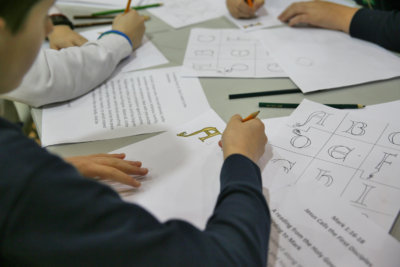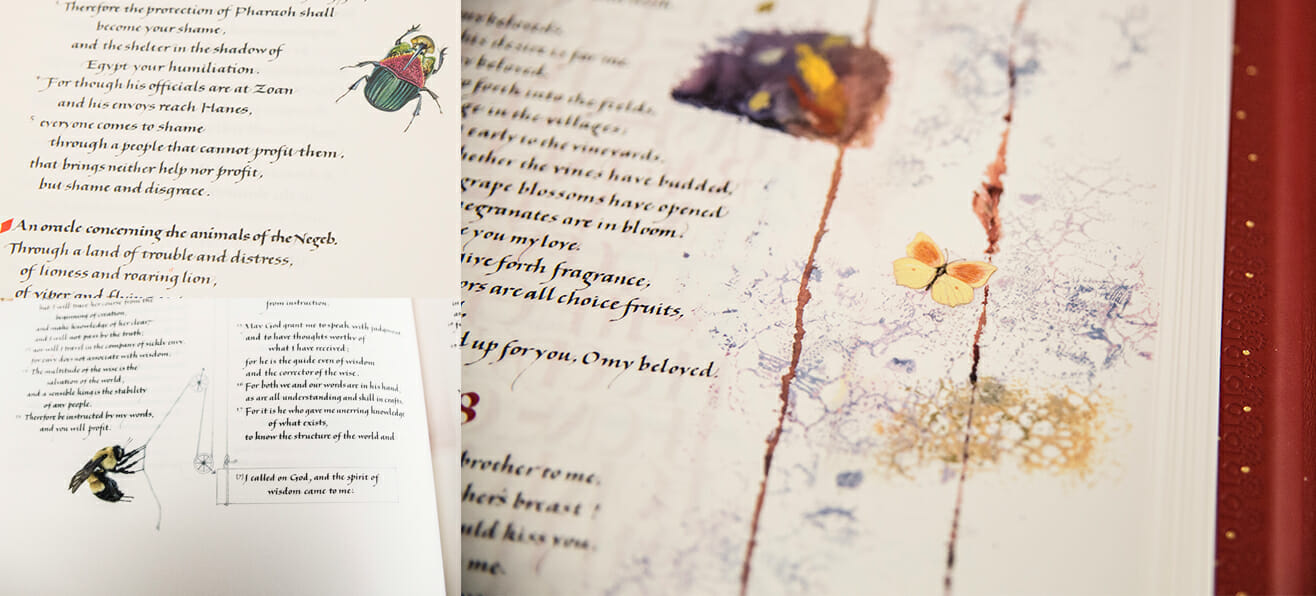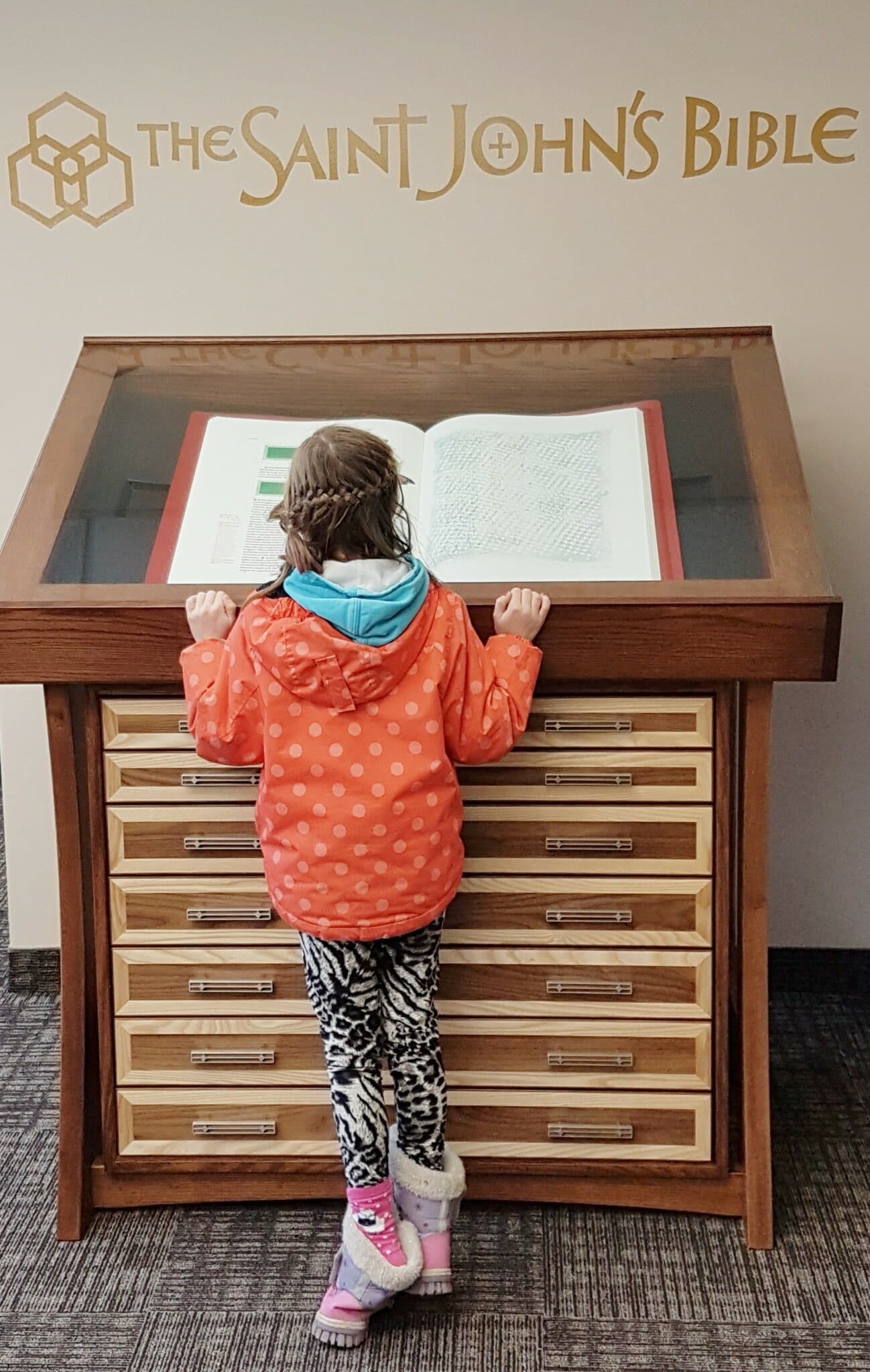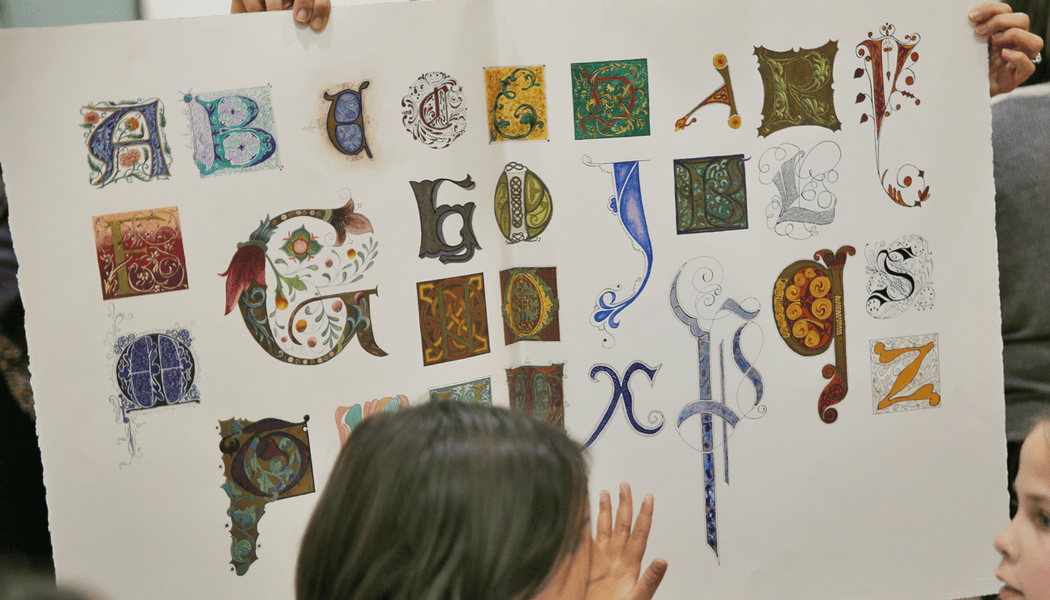How the Diocese of Hamilton Created Unique Experiences to Connect with its Community
Bugs Helped Build a Bedrock for Bible Bookings
Bishop Douglas Crosby knew The Saint John’s Bible had a place in the Diocese of Hamilton in Ontario, Canada, long before it found its way there. The question the Diocese faced wasn’t “if” they would make a place for the Bible – it was “how.”
“Bishop Crosby had been aware of the Saint John’s Bible project since the late 1990s,” said Bridget Ker, Saint John’s Bible Coordinator at the Diocese of Hamilton and Archivist. “He’s very interested in evangelization, so having a new way to present the Word of God was very important to him.” She said the Bible’s earlier visit to St. Jerome’s University was “the spark” that put into motion a plan to bring the Heritage Edition to Hamilton for good. “He was struck by the beauty of The Saint John’s Bible and the new way people can engage with the Bible. It provides a new avenue for people to get close to the scriptures, to have a conversation back and forth with them. That’s a unique way for people to be able to interact with the Bible.”
Diocese of Hamilton Director of Liturgy Christina Ronzio, a student at the College of Saint Benedict & Saint John’s University during production of the original Saint John’s Bible, was another early and enthusiastic supporter of bringing the Heritage Edition to Hamilton.
Grassroots Movement Results in 202 Bookings
 After receiving the first volume in July 2016 with the other volumes following quarterly, the Diocese began inviting its constituents to show or view the Bible. Ker recalls this effort as a “grassroots” movement: “We were able to send word out to the parishes and school boards and other groups within the Diocese that we had it, and the Bible was available for viewing. A few parishes, schools, and groups who had heard about it were the first to host events. Every time we brought it out, someone else said, ‘How can we get it at our group?’ and the roots would spread.”
After receiving the first volume in July 2016 with the other volumes following quarterly, the Diocese began inviting its constituents to show or view the Bible. Ker recalls this effort as a “grassroots” movement: “We were able to send word out to the parishes and school boards and other groups within the Diocese that we had it, and the Bible was available for viewing. A few parishes, schools, and groups who had heard about it were the first to host events. Every time we brought it out, someone else said, ‘How can we get it at our group?’ and the roots would spread.”
Made up of 124 parishes, 227 schools, 22 missions, one Catholic university and more than 600,000 Catholics across a large swath of southern Ontario, the Diocese of Hamilton is the second-largest English-speaking Diocese in Canada. Ker said the project grew “much larger than expected,” with visiting, viewing and displaying requests pouring in from the few seeds the Diocese had planted.
Of the 202 bookings The Saint John’s Bible visited in the Hamilton Diocese (a number Ker said increased toward the end of last year), only 18 were initiated by the Library and Archives of the Diocese of Hamilton. The remaining 184 bookings were by the requests of interested parties.
“It’s been a lot of one-on-one promotion with groups already in the Diocese to get the word out,” said Ker. One recent conversation with the Hamilton-Wentworth Catholic District School Board resulted in 9 bookings. But the interfaith advantage of The Saint John’s Bible helped the Diocese reach groups outside of the Catholic faith, as well.
Ecumenical Outreach Sparks Custom Programming
“One of the things we’ve been surprised by is the ecumenical response The Saint John’s Bible has generated,” she said. The ecumenical aspect has provided the opportunity to create specialized and custom programming around particular themes found in The Saint John’s Bible. For example, during a recent visit to a Presbyterian retreat center, a speaker incorporated her profession as a beekeeper into her presentation. “She had us bring up the volumes of the Bible that have insect imagery,” said Ker, “so that we could complement what she was speaking about.
“The thematic exploration of insects throughout the volumes of The Saint John’s Bible is really interesting. It reflects both the themes of the Gospels and the geographic location where The Saint John’s Bible was created—so there are insects you would see in Wales, where the studio was, and insects you might see outside Saint John’s University in Minnesota. As the volumes progress, they take on a sort of metaphorical relationship to the Scriptures.”
The program is known as “Bugs in the Bible,” a Diocese of Hamilton session dedicated to the significance, symbolism and integration of insects into the art and message of The Saint John’s Bible. The program can include a scavenger hunt in which students – typically kids – match up insects to the passages in which they’re alluded to.

Other programs include “Learning from Our Mistakes,” examining the human errors intentionally left in the finished Saint John’s Bible; “Tools of the Trade,” a workshop focusing on the calligraphy of the Bible, where students create their own decorated versal; and “The Art of The Saint John’s Bible,” an exploration of the tools and materials used to create the Bible’s signature illuminations.
“We’re able to customize what we do depending on the booking group,” said Ker. Schools usually involve hands-on learning opportunities, while presentations, sessions, hands-on viewings and discussions are ideal for larger groups. “It allows us to create relationships with groups outside the Diocese,” said Ker, including, for example, the Hamilton Calligraphy Guild, whose interest was piqued by the Bible’s extensive calligraphic displays.
“Just recently, we were at the Church of Saint John the Evangelist” – an Anglican church – “and they were looking for a Lenten reflection. Dr. Ann Jamison, Director of Catechesis at the Diocese of Hamilton, had developed a visio divina based on the parables in Luke,” which perfectly suited the church’s desires.
A Living Book, Not a Museum Piece

These initiatives, whether based on an entire volume or individual illuminations, reveal the true power of The Saint John’s Bible Heritage Edition: Bringing people closer to art, to God and to each other. “One of the things the Bishop wanted for The Saint John’s Bible was not to be a museum item but to be a living book,” said Ker. “By bringing it out, maybe a corner might get turned. Maybe there might be a smudge. It’s not going to stay pristine forever; it’s going to undergo changes in its lifetime. If we want people to totally engage with it, engaging with it on the tactile level is important, too” – with the simple caveat of “no food, no fire, no water” and freshly washed hands when touching its pages under the supervision of a docent.
Even among the large audiences and far-reaching programs, smaller epiphanies stand out to Ker. “One of our docents met a little girl who said she was inspired to go back and read her own Bible from looking at the illuminations in The Saint John’s Bible,” she said. In another instance, students read the Lord’s Prayer directly from the ink of the Heritage Edition, which differs slightly from the version they had used in Mass. This forced them to analyze the words instead of reciting from memory. “It’s not a dry page. The illuminations and calligraphy truly ignite their spiritual imaginations.”
The Bible Brings People Together in Community
“We didn’t expect the response we got,” Ker added. “It sort of exploded. Because we’re not just doing open viewings, there’s a lot of interaction you can have. Having the Bible on display is a first great step, but there’s so much to explore. We’re incredibly fortunate to have the time, resources and support to be able to do it, but it can start small.”
For the Diocese of Hamilton, a small start has led to three bookings per week through June. At conferences, schools, a musicians’ retreat, youth ministries, a church press conference and more, the Bible is sure to make an impression on a diverse group of people.
“It exists as more than one thing,” said Kerr. “It is a Bible; it is a work of calligraphy; it is a work of art. It’s bringing the Scripture out to the community, to expose it, but it’s also a blessing to bring people together in community. We get to meet so many people and explore with them how it speaks to their hearts, so there’s no reason not to explore.”


